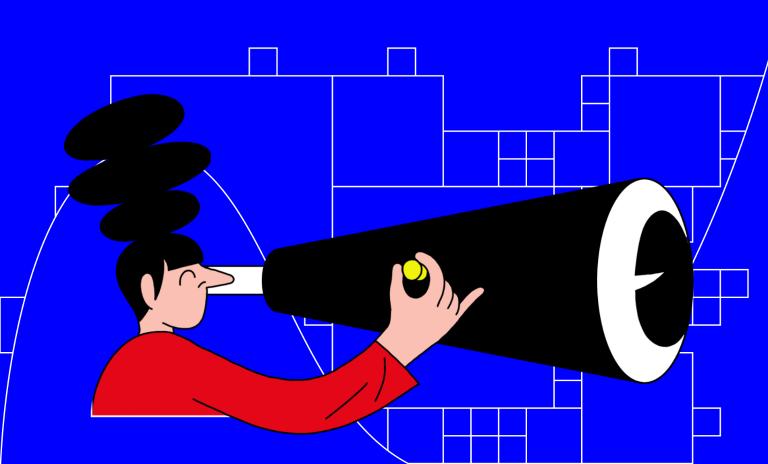The new blueprint for innovation
![{[downloads[language].preview]}](https://www.rolandberger.com/publications/publication_image/ta45_en_cover_download_preview.jpg)
The latest edition of Think:Act prepares us for innovation in 2025 and beyond while faced with constrained resources and uncertainty across the business landscape.
_background_none.png?v=1372397)

by Michal Lev-Ram and Stefan Stern
Illustrations by Simon Landrein
That old adage "innovate or die" still rings true. So how, in a slowing economy, can organizations innovate? Read on to learn how company culture, AI, external stimulation and good old R&D can combine to forge a fresh future.
Some disruptions are more welcome than others. In bumpy economic and political times, businesses have got to be ready to move, and sometimes move fast. That means that today innovation is more relevant than ever. New tech – particularly AI – offers rapid-pace advances and creates new product possibilities and new processes. But a plethora of constraints, from supply chain complications to slower economic growth and environmental concerns, all have a drag effect.

Business now stands at a pivotal moment not covered by the traditional rule book of innovation. So which levers should it reach for? How do you invest in fast-changing technology? And is there a magic bullet for all this? "There's been a change in how we think about innovation over the last decades," says Paul Nightingale, professor of strategy at the University of Sussex Business School in the UK. "We used to think of innovation as something that simply emerged out of R&D, which was probably true in the 1950s because there wasn't much competition and there was a whole bunch of new technologies – plastics, antibiotics – coming out of research," he says. "More recently we've recognized the importance of understanding user needs. So the main driver of innovation success wasn't necessarily whether or not you had good R&D and good science, it was much more about giving users what they wanted. So innovation isn't really R&D – it's design."
Companies might well need to collaborate in new ways in a world where it's no longer adequate to rely on internal expertise – even among those organizations that have always given their employees the freedom to innovate. "Even a company like [pharma giant] GSK will only do 1% of all the science in a particular area," Nightingale says. "They'll need to look outside. So a lot of R&D now isn't just to develop products and services, it's also to be able to understand and judge the quality of research conducted elsewhere."
4x return: How much public investment in R&D could stimulate private R&D investment over the long term, according to a 2024 study.
Source: The National Centre for Universities and Business, UK
The stakes couldn't be higher. Some say the viability of today's corporations is uncertain; others argue that even the progress of humanity is at risk. So as some things accelerate and others slam the brakes, a new challenge arises: How to think differently regarding innovation? Jaideep Prabhu, a professor at the Judge Business School at the University of Cambridge, says that means developing a more sophisticated understanding of how private sector players and governments can collaborate to bring about large-scale innovation. "After the war it was felt that the state would have to invest heavily in R&D, defense and so on. This would eventually trickle into the private sector," he says. "But this morphed in the 80s/90s into the other end of things: The state at most will do the regulation and let the private sector get on with it. That's still the dominant paradigm in the West. If anything, it will be more so in the US Trump era," he says.
But there is a third way, he adds, where the state and the private sector work together, but neither side really dominates … and you have guardrails. "The state can use its power when it makes sense. But equally the design principles of collaboration encourage a level playing field in terms of competition and don't actually favor incumbents and big players, because then you would have a monopoly." [For more on "frugal innovation," see the box below]
A well-worn example of successful innovation is 3M's process to produce the Post-it Note. It arose from one man's accidental discovery and another's accidental application for it. A scientist at 3M was frustrated with loose bookmarks. Then he remembered that a colleague had invented a tacky glue he couldn't put to a useful purpose. The two of them talked and came up with a product no one knew they needed, but which now sells more than 50 billion notes a year.

Magic can happen when workers have freedom to explore, but the process needs leadership to thrive.
The secret sauce that led to the invention of the Post-it Note, so the story goes, isn't what was in the literal glue. It was rather the metaphorical glue of 3M's culture which promoted informal, unsanctioned innovation. Others including Google with its "side project time" have emulated that culture of giving workers time and space to tinker outside the constraints of the day-to-day responsibilities. But the real thing at play here which we cannot duck is an important human factor: Innovation processes have to be managed.
As Paul Nightingale explains, this is partly about the need to capture value. "This is an idea that comes from David Teece at Berkeley," he says. "Lots of firms innovate, but they fail to capture the benefits of it and other firms come along and just copy them … Those two things, creating value and capturing value, collectively define the business model of the firm. That's a really big intellectual development. And all of that needs to be managed and coordinated within firms. Typically you'll have junior managers who will coordinate all that knowledge within a function. Middle managers will coordinate between functions in an organization and senior managers will reach out and form relationships and joint ventures and connections with inputs to that innovation process, both locally, because of the importance of face-to-face interaction, but also internationally. So you've got this kind of new division that's going on there. And they need to create that culture which will enable the political process of innovation."
Nightingale goes on to clarify that "innovation within organizations creates internal winners and losers. And can be beaten up by too much bureaucracy and political infighting. One of the most important drivers of success is having empowered project managers who use their elbows to force through major changes that industries and companies may not find easy to make."
There's one more point he wants to make clear: "Innovation is inherently uncertain. There's a classic knowledge element to technology. Knowledge is passed on face-to-face. There are judgment calls that are vital in all of this. It's a distributed activity, both within firms and also increasingly externally now. It means those 'soft skills' are more and more important," Nightingale says.
The developing world has been in on a secret for decades: You can do more with less.
"New entrants in emerging markets find ways to repurpose or reuse what they have in their hands," says Navi Radjou, an innovation and leadership advisor and the author of several books on frugal innovation. "They improvise using the resources that already exist around them."
Radjou says that while this method of innovation used to be limited to emerging economies, he has seen several examples of this approach being adopted by Western companies. The reason, he says, is that resources like water, electricity and capital are getting scarce – or at least unpredictable – even in the developed world. "Rather than complain about lack of resources, frugal innovation teaches you to think like in martial arts – how do you transform adversity into opportunity?" he explains.
Take a farmer in India who developed a refrigerator made entirely of clay. It does the same thing a similar product does in the West but more cheaply – no electricity required. In the West, similar examples are growing. The Germany-based, industrial conglomerate Siemens embraced frugal innovation after years of operating in and learning from India and China. The company has developed low-cost CT scanners that can be deployed with less energy than traditional machines. French automaker Renault has also learned from its experience in emerging markets, developing low-cost electric cars it sells globally.
Jaideep Prabhu, a professor at Cambridge University, studied the launch and development in India of the unique ID system, which took the country rapidly from a largely cash-based society in 2009 to one in which 700 million citizens acquired secure ID for welfare benefits and online banking, with each unique ID costing only $1 a time. This was a powerful collaboration between government and the private sector. And a highly frugal one.
In the United States, too, there is growing interest in frugal innovation, says Radjou. Part of this comes from profit motivation, of course – the more you can do with less, the more you make. But he expects that interest will continue to expand for other reasons. In a world with growing constraints, it's hard to see a future where at least frugality doesn't become more abundant.
Navi Radjou is a scholar and leadership advisor.
Jaideep Prabhu is a professor of business and enterprise at the Judge Business School at the University of Cambridge.
They are the co-authors (alongside Simone Ahuja) of the 2012 bestselling book Jugaad Innovation: A Frugal and Flexible Approach to Innovation for the 21st Century.

Technology is rapidly building up a new toolbox for innovators to tinker with, but it will be useless without human expertise.
Old approaches on their own, then, are no longer sufficient. Luckily, there are other tools at hand. Digitalization, automation and, yes, even AI, are nothing new at Unilever, the London-based maker of consumer goods including soap, mayonnaise and ice cream. But over the last few years, the way the conglomerate harnesses technology has changed drastically. Instead of being a tool for optimizing back-end processes, AI has become predictive and productive, assisting the company in one of its most critical pursuits, the creation of new goods. "AI allows us as product developers to have a much bigger toolbox," says Manfred Aben, the head of R&D, science and technology for Unilever's nutrition division.
At Unilever, AI is now being used to do things like calculate the best combination of ingredients. The company is even putting it to work to predict the taste and texture of new forms of mayonnaise, including devising a plant-based formula that's easier to squeeze out of the container it comes in. "Traditionally we did all of this by trial and error, with chefs cooking products," says Aben. "We still do that today but now we also use these tools to find ingredients and new ways of processing."
Here's another example: When Unilever wanted to create a new bouillon cube with zero salt, it turned to AI for inspiration. The challenge wasn't just one of taste, it was also about structure. "Making a cube without salt is like building a house without bricks," says Aben.
Instead of manually tinkering with different combinations of ingredients, Unilever was able to use AI to run simulated models for both taste and structure using millions of natural ingredients. The end result is a formula that Aben can't share. But, says the long-time researcher, it works. And as it turns out, those little cubes of compressed flavor translate to big money – Knorr, Unilever's bouillon brand, recently hit the $5 billion milestone.
The recent volatility in global markets makes AI an even more valuable creative partner for employees, according to Aben. There are many variables in creating new product lines in today's world. At a company like Unilever, which works with natural materials like herbs, spices and vegetables, all sorts of unexpected and uncontrollable changes in the world – including geopolitical strife – can lead to a number of disruptions when it comes to manufacturing its products. "I think the whole role of the product developer will change and AI will allow us to develop food products in completely new ways," says Aben. "It will come up with combinations of ingredients that we couldn't come up with ourselves."
Nightingale also acknowledges the potential of AI in innovation, but with a warning. "AI is going to change things," he says. "But typically AI is the average of the internet. And that isn't enough. You need expertise. It's a tool, a complement rather than a replacement. It's like having a very, very hardworking, pretty clever research assistant who happens to be a pathological liar every now and then. It takes a lot of expertise to know when they are just making stuff up. But if you do have that, and you can use them well, then that's much better."
500 applications: The number of different ways Unilever says it is now utilizing AI as a development tool across its many departments.
Source: Unilever
Technology is no longer just in the hands of the technologists. And it isn't just AI features that are available to all sorts of employees. The popularity of low-code and no-code tools, which allow anyone to create applications without writing code, are also readily on hand. But while using these types of software is becoming easier and easier, it also requires a comfort level which not everyone is accustomed to. And it requires a new way of working both independently and with others. "The siloed specialist is no longer possible," says Aben, referring to the empowerment AI can afford all employees. "Today, almost everyone interacts with these systems in one way or another." At Unilever, that means everyone from IT specialists to flavor scientists. According to Aben, there are now more than 500 applications of AI across the company's business.
Unilever isn't the only company that is using AI to "outsource" – or rather augment – some of its most critical and creative functions. More organizations are experimenting with how AI can be used to help employees in all sorts of creative processes, including innovation. Collaborating with AI will require workers to exist side by side with technology in a new way. But still, it won't replace an established real-world alternative which doesn't involve computers at all.
The processes by which innovation occurs are every bit as diverse as the outcomes they can create.
Just as there are multiple approaches to innovation, there are also a multitude of types of innovation. And they're not one-size-fits-all. The type that's right for your company depends on many factors. There are also external forces at play, like market conditions, which also help dictate which type of innovation is optimal at a particular time.
At one end of the spectrum are moonshots, those pie-in-the-sky projects that are undertaken with seemingly no assurance of near- or even far-term success. Because of the high risk of failure, these types of innovative endeavors are particularly attractive to startups, where the fact that most bets don't pay off is baked into the model.
At the other end is incremental innovation, where refinements are made to existing products over time. This can work well for large organizations that develop complex products, like the iPhone. The first iPhone, by the way, also falls under the category of a market-creating innovation. Even though it wasn't the first smartphone, it jump-started the category. Like moonshots, market-creating innovations are high-risk – and not for everyone.
So what's in the middle of the spectrum? As it turns out, a lot. According to Harvard Business School Professor Regina Herzlinger and her colleagues, the opportunities that fall between the two extremes of innovation include augmented and synergistic innovation. Augmented innovations "significantly improve upon" existing products, without completely disrupting them. As for synergistic innovations, these are new products that "derive value from their adjacency to existing products."
These two types of innovation aren't often talked about, but they can be effective engines for corporate growth. Again, there's no one way to "do" innovation. And settling on the right type takes a level of, well, innovative thinking.

"In the olden days, firms were very focused on their own internal experts. Now, it's about more open ecosystems."
Rapid development in both IT and AI could mean more efficient and cost-effective innovation, but how?
At the turn of the 21st century, several big players took some novel turns and looked to ways of collaborating with external players for innovation. Procter & Gamble had its Connect + Develop scheme to bring in external ideas to beef up its R&D. IBM nurtured its Innovation Jam encouraging employees and customers to solve problems together. InnoCentive – an open innovation and crowdsourcing company – were at the forefront of exploring open problem-solving too. It built a network of experts around the world to take on challenges both technical and scientific to gain new perspectives and accelerate innovation. All these examples show an open-minded way to bring in ideas from the outside. So it wasn't anything very new when a decade or so ago, Melissa Valentine, professor of management science at Stanford University, began looking into a related phenomenon dubbed "flash teams."
Companies had already been leveraging the growing, so-called "gig economy" to bring in contractors for all sorts of mundane, easily outsourced needs. She noted that some organizations were now tapping into a diverse pool of largely external disciplines to do more creative, experimental work like iterating on a product, bringing it from concept to fruition quickly – and then disbanding. Flash teams, Valentine and her fellow researchers argued, could be "combined to create new types of organizations with completely fluid boundaries – organizations that are composed of many smaller flash teams, each of which are spun up on demand, work in parallel, and disperse when complete."
$10 trillion: How much GenAI developments have been forecast to add to global GDP by 2033.
Source: IDC/Microsoft
From a historical point of view, many organizations have bristled at the very thought of "fluid boundaries." More often than not, the status quo was to protect your intellectual property at all costs, not to share it – even for the purposes of innovation. But more recently, many organizations have started to embrace more openness. That can take several forms. Yes, there are flash teams, which Valentine says have matured and evolved in recent years. But there are also increased partnerships with startups, universities and external research labs. "In the olden days, firms were very focused on their own internal experts," says Valentine. "Now, it's about more open ecosystems." It isn't a new phenomenon to bring the outside in, indeed it echoes the initiatives of IBM and P&G, but it is pertinent to 2025 and beyond and has a part to play as a tool in the box to get innovation working in challenging and unpredictable times.
Companies that once relied on their own internal expertise can credit looking outward for much of their more recent innovation. Take Microsoft, an organization which for years shunned innovation partnerships. And yet, starting in 2022, the technology giant made an aggressive foray into GenAI not with its own internal project, but by investing in and partnering with OpenAI. The bold bet cost Microsoft $13 billion, but it also allowed it access to the most cutting-edge of GenAI technology.
However, opening itself up to other companies' technology didn't just require Microsoft levels of cash, it also required a new, uncomfortable approach: the simple recognition that no one company – not even the biggest tech giants in the world – has all of the expertise that is needed to compete in today's fast-moving world. "Companies don't want to get left behind with AI and now with GenAI," says Valentine. "And most don't have all of the AI experts they need."
At 3M too, the focus has shifted from purely internal to external. "The kind of innovation that's needed now will require ecosystem partnerships and more radical collaboration than we've done before," says Jayshree Seth, 3M's chief science advocate and an inventor with 80 patents to her name. "No one company can do it alone." Is this plural approach, then, the magic bullet? What about the tried-and-tested route of research and development?

Innovation is as much an issue of technique as it is of tech, and frugal times will require creativity.
Economic pressure has had an impact on some R&D budgets. Cuts and revisions have pushed some companies to do more with less. But such clear restrictions make it difficult for employees to devote a significant percentage of their time to passion projects. That has a cost for innovation. Fresh analysis from Moody’s has shown that worldwide R&D spending in 2023 was lower than the growth rate in 2022. The message seems to be clear: Post-pandemic belt-tightening, including, in some cases, scaling down workforces or decreasing the rate of new hires, is threatening the pace of innovation.
19% of revenue: How much of total revenue the pharmaceutical industry invested into R&D in 2023, spending ahead of both the software and ICT services sectors, both of which invested 14%.
Source: Moody's
On the other hand, those listed companies with surplus funds have also found it hard to convince shareholders that their investment in R&D is a good idea, even if it could lead to greater and more successful innovation. A board director from a distinguished UK industrial company recently said that a certain degree of subterfuge in accounting practices was required to hide from shareholders just how much R&D spending was going on. Of course, some mature businesses may not need a vast R&D budget. But any company that wants a future needs to think – and think hard – about intelligent and targeted R&D. Perhaps capital is not quite as surplus to requirements as you might think.
Whatever the constraints, there are further roadblocks to innovation beyond the challenge of finding time, space and money for valuable R&D. Dwindling natural resources and supply chain complications continue to plague the economy. And then there is the prospect of trade wars hoving into view. So, some other strategies, such as frugal innovation, which has existed in the developing world for decades, are perhaps now ripe for a revisit.
With all this in mind, developing a blueprint for innovation is almost an innovation task in itself, requiring some fresh thinking and responses to the new tech tools on offer and building them into a methodology that fits. Despite the growing fears that now surround AI, people matter more than ever when it comes to innovation. In short, innovation is not a tech issue, it is a technique issue – and in 2025 and beyond, the digital tools need to be in the right hands, embedded in the right culture and applied in new ways.


![{[downloads[language].preview]}](https://www.rolandberger.com/publications/publication_image/ta45_en_cover_download_preview.jpg)
The latest edition of Think:Act prepares us for innovation in 2025 and beyond while faced with constrained resources and uncertainty across the business landscape.
